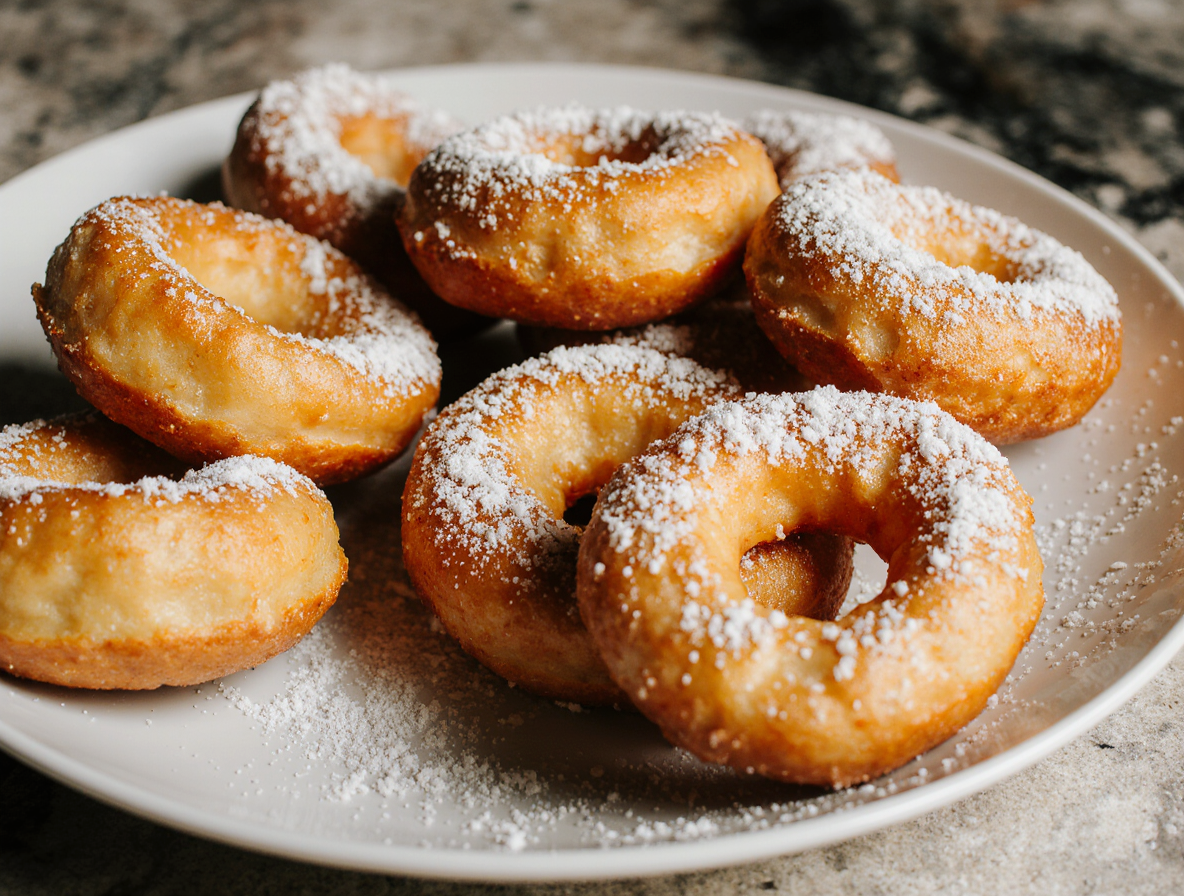How to Make Perfect Baked Beignets: The Secret New Orleans Method
Fluffy beignets baked in the oven offer all the pillowy sweetness of this beloved pastry without the hassle of deep frying. These powdered sugar-dusted squares of dough trace their origins to France, where they were first created as simple fried pastries. Although traditionally deep-fried until golden brown (the word “beignet” actually translates to “fritter” in English), I’ve discovered that baking provides a delicious alternative that’s perfect for home bakers.
What makes these oven baked beignets so appealing? For starters, they require minimal rising time—just 15 minutes of initial rest before rolling out the dough, followed by a quick 30-minute rise before baking. Can you bake beignets and still maintain their authentic taste? Absolutely! While deep frying is the classic method, our baked beignets recipe delivers that characteristic soft, pillowy texture you crave. Whether you’re celebrating Mardi Gras or simply indulging your love for Southern cuisine, learning how to bake beignets at home opens up a world of possibilities with less mess and fuss. In this guide, I’ll walk you through each step to create perfect baked beignets that would make New Orleans proud.
What Makes a Beignet a New Orleans Classic
The square, sugar-dusted treats we know as New Orleans beignets have a rich cultural history that spans continents and centuries. These iconic pastries represent more than just fried dough—they embody the fusion of cultures that makes New Orleans cuisine so distinctive.
The French roots and Creole twist
New Orleans beignets trace their ancestry to France but evolved significantly through their American journey. French-Creole colonists introduced these treats to Louisiana in the 18th century, bringing with them culinary traditions that would transform in the New World. Initially, many early recipes appeared in the Picayune Creole Cook Book (1900) under the heading “Fritters,” described as traditionally served “piled with snowy sugar.”
The word “beignet” itself reveals its complex heritage—originating from the Celtic word “bigne,” meaning “to raise.” Though considered French pastry today, beignets have connections to ancient Rome, where similar treats called “scriblita” were made from moist dough cooked in boiling animal fat.
What truly distinguishes New Orleans beignets is their Acadian influence. French colonists first brought beignets to Canada before Acadian migrants (later known as Cajuns) carried the tradition to Louisiana. Consequently, the New Orleans version became a cultural fusion—less a pure French import than a creole creation born of necessity and adaptation.
Why powdered sugar is non-negotiable
The generous coating of powdered sugar isn’t merely decoration—it’s an essential element of authentic New Orleans beignets. Traditionally served hot with powdered sugar for breakfast or as a dessert, this sweet dusting transforms simple fried dough into something magical.
At Café du Monde, established in 1862 at the French Market, beignets are always served in orders of three with a substantial blanket of powdered sugar. Furthermore, they’re traditionally paired with café au lait, a coffee drink made with dark roast coffee, chicory, and equal parts warm milk—a combination that balances the sweetness perfectly.
Baked vs. fried: a cultural shift
The concept of baked beignets represents a modern adaptation of a deeply traditional food. Classic New Orleans beignets are, by definition, fried—the word “beignet” literally translates to “fritter” in English. The traditional method involves cutting dough into squares before frying them in hot oil until they puff up and turn golden brown.
In contrast, baked versions emerged as health-conscious alternatives to traditional deep-frying. Despite this departure from tradition, many home bakers find that oven baked beignets can capture much of the texture and flavor of the original, particularly when finished with a light brush of butter before adding the signature powdered sugar coating.
Interestingly, the name “beignet” itself represents a cultural shift. Until 1958, these treats were commonly called “doughnuts” or “French Market doughnuts.” The rebranding to “beignets” coincided with increased tourism and cultural appreciation, with one Times-Picayune columnist noting that “the good old doughnut has gone cultural on us.” Their cultural significance was officially recognized when Louisiana named the beignet its official state doughnut in 1986.
Essential Ingredients and Tools for Baked Beignets
Creating successful baked beignets requires attention to specific ingredients and tools that contribute to their distinctive texture and flavor. Let’s explore what makes each component essential for that perfect New Orleans-inspired treat.
Choosing the right flour and yeast
The foundation of any great beignet starts with the flour. Bread flour, with its higher protein content of 12-14%, creates the ideal structure for beignets. This higher protein means more gluten development, giving beignets their characteristic chewy-yet-tender texture with just the right amount of airiness. Moreover, bread flour produces an elastic crumb with medium-size air bubbles throughout, rather than one giant air bubble surrounded by dense dough.
As for yeast, fresh active dry yeast is critical for proper rising. During proofing, the yeast mixture should be foamy and bubbly – a sign of its vitality. For optimal activation, use lukewarm water between 110-115°F. If water is too hot, it kills yeast cells; too cold, and the yeast remains dormant. Some recipes include diastatic malt powder as an optional ingredient to boost fermentation by breaking down complex starches into simpler sugars, ultimately enhancing structure, texture, and browning.
Why buttermilk and butter matter
Buttermilk transforms ordinary beignets into something special. During testing, versions made with buttermilk were unanimously preferred for their slight tanginess compared to those made with regular milk. Additionally, buttermilk has lower fat content and higher acidity than whole milk, which helps tenderize the gluten in flour, resulting in lighter, fluffier texture.
Unsalted butter plays several crucial roles in beignet dough. First, it adds richness and moisture. Second, it interferes with gluten formation, creating that tender crumb beignets are known for. Without butter, beignets would be tough and chewy. For best results, butter should be completely softened to room temperature (ideally between 65-67°F) for proper incorporation into the dough.
Tools that make the process easier
Successful baked beignets require several essential tools. A stand mixer with a dough hook attachment saves considerable effort when kneading the sticky dough. A good dough scraper helps manage the dough during transfer and cutting. Likewise, precise measuring tools (cups, spoons, and a kitchen scale) ensure consistency.
For baking, you’ll need rimmed baking sheets lined with parchment paper and a pastry brush for applying butter after baking. A rolling pin coated with flour prevents sticking when rolling the dough to approximately ½-inch thickness. Finally, a sifter or fine-mesh strainer makes applying the signature powdered sugar coating much easier and more even.
Step-by-Step: How to Bake Beignets at Home
Making your first batch of beignets baked at home is simpler than you might think. With precise steps and a bit of patience, you’ll soon be enjoying these New Orleans-inspired treats without the mess of deep frying.
1. Activate the yeast properly
First, combine warm water (between 110-115°F), a pinch of sugar, and active dry yeast in a small bowl. Stir gently and let the mixture sit undisturbed for 5-10 minutes. You’ll know your yeast is ready when it becomes foamy and bubbly on top. If nothing happens after 10 minutes, your yeast might be dead or your water temperature was off – start over with fresh yeast.
2. Mix and knead the dough
Once your yeast is activated, combine it with the wet ingredients (egg, buttermilk, and vanilla) in your mixing bowl. Gradually add the dry ingredients, starting with about half the flour. For best results, use a stand mixer with a paddle attachment initially, then switch to a dough hook after incorporating all ingredients. Add melted butter in small pieces, allowing each to incorporate before adding more. The dough should feel tacky but not overly sticky – it should begin pulling away from the sides of the bowl during kneading.
3. Let the dough rise the right way
Place your kneaded dough in a lightly oiled bowl, turning once to coat all surfaces. Cover tightly with plastic wrap to prevent drying out. Allow the dough to rest in a warm, draft-free area for about 30-45 minutes until it doubles in size. Because beignet dough is enriched with butter and sugar, it may take longer to rise than standard bread dough.
4. Cut and shape the beignets
On a generously floured surface, roll the dough into a rectangle approximately ¼-inch thick. Using a sharp knife or pizza cutter, cut the dough into 2-inch squares. Don’t worry about perfect shapes – slightly irregular beignets have their own charm.
5. Bake to golden perfection
Preheat your oven to 400°F. Place the cut beignets on a parchment-lined baking sheet about 1 inch apart. Allow them to rest covered for another 30 minutes – this final rise is crucial for achieving that light, airy texture. Bake for 10-12 minutes or until the tops turn golden brown.
6. Finish with butter and sugar
Immediately after removing from the oven, brush the hot beignets with melted butter. Essentially, this helps the powdered sugar adhere while adding richness. Generously dust with powdered sugar – traditional beignets should be nearly buried in it. Serve hot for the authentic experience.
Tips, Variations, and Troubleshooting
Perfect baked beignets require some problem-solving skills and creative adaptations. Even experienced bakers face challenges with these delightful treats, yet simple adjustments can make all the difference.
How to make baked beignets without yeast
Preparing beignets without yeast is surprisingly straightforward. Instead of yeast, use baking powder to create lift in your dough. Opt for bread flour over all-purpose flour whenever possible, as its higher gluten content provides better structure and elasticity, creating a texture closer to traditional yeast beignets. Test your baking powder first by mixing two teaspoons into one cup of hot water—if it bubbles immediately, it’s still active. Unlike yeasted versions, these quick beignets don’t require kneading. Simply rest the dough for about fifteen minutes before proceeding.
Common mistakes and how to fix them
The biggest mistake when making beignets is overmixing the dough. This creates too much gluten, resulting in tough, lifeless pastries. Similarly, rolling the dough too thin leads to flat beignets. If your beignets aren’t puffing properly, try increasing your oven temperature slightly or ensuring your dough is between ¼ to ½ inch thick. For sticky dough problems, add flour gradually until manageable, as substituting all-purpose for bread flour often requires additional flour.
Flavor variations: cinnamon, vanilla, and more
Enhance your beignets with complementary flavors. A light dusting of cinnamon mixed with powdered sugar creates a warm, aromatic twist. Alternatively, adding vanilla extract to the dough imparts subtle sweetness. For special occasions, consider incorporating citrus zest or almond extract. Remember to store unflavored dough if planning variations—this allows you to experiment with different toppings as needed.
Can you use an air fryer instead?
Absolutely! Air fryers offer excellent results with less oil. Preheat your air fryer to 350°F, place beignets in a single layer (never overlapping), and cook for 2-3 minutes until heated through and crispy. For best results, mist beignets lightly with water before air frying to rehydrate the surface. This method delivers crispness remarkably similar to traditional fried versions.
How to store and reheat leftovers
Fresh beignets remain good for only 30 minutes after preparation. For storage, first cool completely on paper towels to absorb excess oil. At room temperature, they’ll last 2-3 days in an airtight container. Refrigeration extends freshness to one week, yet freezing is ideal for longer storage—up to three months when properly wrapped.
For reheating, the oven method at 350°F for 5 minutes yields the best results. Air fryer reheating (350°F for 3 minutes) creates a wonderfully crisp exterior. If you’re in a hurry, microwave for 10-20 seconds, using 10-second intervals to prevent sogginess. Preferably wait to add powdered sugar until after reheating for optimal presentation.
Conclusion
Baked beignets truly offer the best of both worlds—all the delightful flavors of traditional New Orleans pastries without the hassle of deep frying. Throughout this guide, we’ve explored how these pillowy squares of dough have evolved from their French origins into beloved Creole classics, albeit with a healthier twist through baking rather than frying.
Undoubtedly, the right ingredients make all the difference. Bread flour creates that perfect chewy-yet-tender texture, while buttermilk adds a subtle tang that elevates the flavor profile. Additionally, proper yeast activation serves as the foundation for that signature airy interior we all crave.
Although traditionally fried, our baked version maintains the essence of authentic beignets while simplifying the process for home bakers. After all, the generous dusting of powdered sugar remains non-negotiable, regardless of cooking method. During my testing, I found that brushing hot beignets with butter before adding sugar helps recreate that beloved New Orleans experience.
Whether you choose to follow the traditional recipe or experiment with variations like cinnamon or vanilla, these beignets will transport you straight to the French Quarter. Previously, I mentioned that beignets are Louisiana’s official state doughnut—a testament to their cultural significance and enduring appeal.
Last but certainly not least, remember that beignets are best enjoyed fresh, preferably still warm from the oven and accompanied by a cup of coffee. Therefore, gather your ingredients, preheat your oven, and bring a taste of New Orleans into your kitchen. Before long, you’ll wonder why you ever hesitated to make these delectable treats at home.
FAQs
Q1. What’s the key to making perfect baked beignets? The key is using the right ingredients and techniques. Use bread flour for the ideal texture, activate the yeast properly, and let the dough rise correctly. Brush the baked beignets with butter before dusting generously with powdered sugar for an authentic taste.
Q2. Can beignets be made without yeast? Yes, you can make beignets without yeast by using baking powder instead. Use bread flour for better structure and elasticity, and let the dough rest for about 15 minutes before shaping and baking.
Q3. How do New Orleans beignets differ from French beignets? New Orleans beignets are typically smaller, lighter, and hollow inside compared to French bakery beignets. They’re also traditionally rolled in powdered sugar, which is a signature characteristic of the New Orleans style.
Q4. What are common mistakes to avoid when making beignets? Common mistakes include overmixing the dough, which can make the beignets tough, and rolling the dough too thin, resulting in flat pastries. Also, ensure your oven temperature is correct and the dough thickness is between ¼ to ½ inch for proper puffing.
Q5. How should leftover beignets be stored and reheated? Store cooled beignets in an airtight container at room temperature for 2-3 days, or freeze for up to three months. To reheat, use an oven at 350°F for 5 minutes or an air fryer at 350°F for 3 minutes for best results. Add fresh powdered sugar after reheating.


